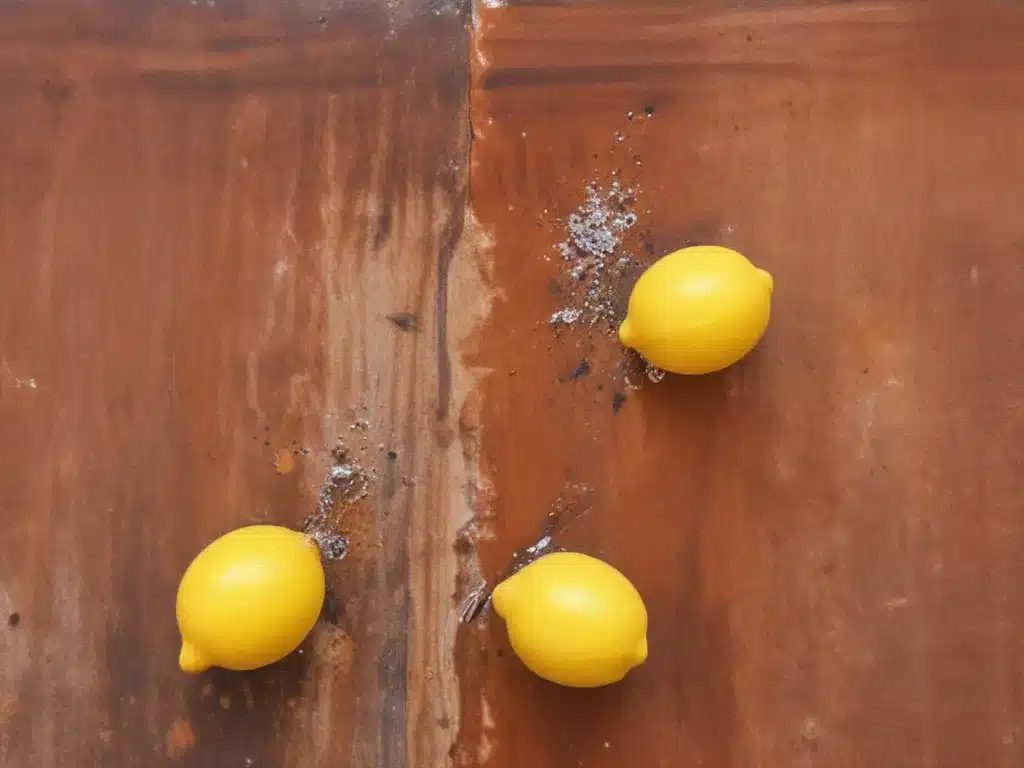What are Rust Stains?
Rust stains are discolored spots or patches that form on surfaces due to the oxidation of iron or steel. These stains can appear reddish-brown or yellowish-brown in color and can be quite stubborn to remove. Rust stains can occur on various surfaces, including metal objects, fabrics, concrete, and even plastic.
Rust stains on metal objects are a common occurrence as the iron in the metal reacts with oxygen and moisture, resulting in the formation of iron oxide (rust). This process is accelerated by exposure to water, humidity, and certain chemicals. Rust stains on fabrics, on the other hand, can occur when clothing or linens come into contact with rusted metal objects or water containing dissolved iron.
In addition to being unsightly, rust stains can also weaken the structural integrity of metal objects and fabrics over time. Therefore, it is essential to address rust stains promptly to prevent further damage and maintain the appearance and longevity of the affected items.
Why Use Lemon and Salt to Remove Rust Stains?
Lemon and salt are two natural and readily available household ingredients that can be highly effective in removing rust stains. The combination of these two ingredients creates a powerful cleaning solution that can tackle even the most stubborn rust stains.
Lemon:
Lemon is a natural source of citric acid, which is a mild acid that can help to break down and dissolve rust stains. The citric acid in lemon acts as a chelating agent, which means it can bind to and remove metal ions, including iron ions present in rust stains.
Salt:
Salt, or sodium chloride, acts as an abrasive material that can help to loosen and lift rust stains from surfaces. When combined with the acidic properties of lemon, salt can enhance the cleaning power of the solution, making it even more effective at removing rust stains.
The combination of lemon’s acidic properties and salt’s abrasive nature creates a potent cleaning solution that can effectively break down and lift rust stains from various surfaces without the need for harsh chemicals or expensive commercial cleaners.
How to Remove Rust Stains with Lemon and Salt
Here is a step-by-step guide on how to remove rust stains using lemon and salt:
Materials Needed:
- Fresh lemon(s)
- Salt (coarse or table salt)
- A clean cloth or sponge
- A small bowl or container (for mixing)
- A toothbrush or scrub brush (optional, for stubborn stains)
Step 1: Prepare the Lemon and Salt Solution
Cut a lemon in half and squeeze the juice into a small bowl or container. Add a few tablespoons of salt to the lemon juice and stir to create a paste-like mixture.
Step 2: Apply the Lemon and Salt Solution
Use a clean cloth or sponge to apply the lemon and salt solution directly onto the rust stain. Gently rub the solution into the stain, ensuring it covers the entire affected area.
Step 3: Let the Solution Sit
Allow the lemon and salt solution to sit on the rust stain for at least 15-20 minutes. The longer you let it sit, the more time the acidic and abrasive properties of the solution have to work on breaking down and loosening the rust stain.
Step 4: Scrub the Stain (if necessary)
For stubborn rust stains, you may need to use a toothbrush or scrub brush to gently scrub the affected area after letting the solution sit. The abrasive action of scrubbing, combined with the lemon and salt solution, can help to further loosen and remove the rust stain.
Step 5: Rinse and Repeat (if needed)
Once you have scrubbed the stain, rinse the area thoroughly with clean water to remove any remaining residue. If the rust stain persists, you can repeat the process by applying a fresh lemon and salt solution and letting it sit for a longer period.
Step 6: Dry and Protect the Surface
After successfully removing the rust stain, ensure that the surface is thoroughly dried. For metal surfaces, you may want to apply a protective coating or sealant to prevent future rust formation.
Tips and Precautions
- Test the lemon and salt solution on a small, inconspicuous area first to ensure it does not cause any discoloration or damage to the surface.
- Wear gloves when handling the lemon and salt solution to protect your hands from the acidic mixture.
- Avoid using this method on delicate surfaces, such as fabrics or surfaces with a painted or varnished finish, as the acidic nature of the solution may cause discoloration or damage.
- For large or heavily rusted areas, you may need to seek professional assistance or use more specialized rust removal methods.
- Always rinse and dry the surface thoroughly after removing the rust stain to prevent further oxidation or damage.
Conclusion
Removing rust stains can be a challenging task, but the combination of lemon and salt provides a natural, effective, and inexpensive solution. By harnessing the acidic properties of lemon and the abrasive nature of salt, this homemade cleaning solution can tackle even the most stubborn rust stains on various surfaces.
Remember to exercise caution when using this method and always test it on a small, inconspicuous area first. With a little patience and elbow grease, you can effectively remove rust stains and restore the appearance of your affected items.
If you need professional assistance with removing rust stains or other cleaning services, consider AdamCleaning.uk, a reputable cleaning company that offers a wide range of solutions to meet your needs.







